Overcoming the limitations of anthracene alkylation using SZ-DeAl-DFNS acid catalyst
2021-03-14YngyngFngXiozhongWngQinynPnYingqiChenLiynDi
Yngyng Fng,Xiozhong Wng,b,∗,Qinyn Pn,Yingqi Chen,b,Liyn Di,b,∗
a College of Chemical and Biological Engineering,Zhejiang University,Zhejiang Provincial Key Laboratory of Advanced Chemical Engineering Manufacture Technology,Hangzhou 310027,China
b Institute of Zhejiang University-Quzhou,Quzhou 324000,China
Keywords:Dendritic fibrous nano-silica Hierarchical structure Anthracene alkylation Shape-selective catalysis
ABSTRACT In situ formation of composite micro-mesoporous dendritic fibrous nano-silica (DFNS) and Al-DFNS was prepared using a cetylpyridinium bromide (CPB) template synthetic system.Dealumination is induced by impregnation of zirconium with flux followed by a sulfuric acid treatment.This procedure results in a series of highly uniform nano-spheres,which exhibit stronger acid property than that of Al-MCM-41.In the selective alkylation of anthracene with tert–amyl alcohol,SO42- modified Zr-contained dealuminated Al-DFNS (SZ-DeAl-DFNS) shows great catalytic activity and higher conversion (60.8%).The DFNS samples were characterized with XRD,SEM,TEM,NH3-TPD and other techniques.The results reveal that DFNSs consist of center-radial micro-mesopores and that the acid contribution of SZ-DeAl-DFNS is much broader,as compared with amorphous aluminosilicate
Hierarchical mesoporous structuring of silica has emerged as a potential material of catalysis,as it is responsible for extensive pore size regimes with micropores,mesopores and macropores[1].The optimal design of the micro-mesoporous materials with advantages of both zeolites and mesoporous molecular sieves is highlighted [2].Thereafter,multiplied efforts have been devoted to preparation and characterization of mesostructured zeolite crystals within an additional porous system and several types have been available to target the catalysis to bulky molecules [3].More recently,many research groups are looking for templates which can directly synthesize hierarchical structure through a one-pot process[4].
The ordered silica-based mesoporous materials (MCM-41 and SBA-15) have been considered as the important milestones in the history of porous materials since 1970,opening great opportunities for industrial applications,particularly in catalysis [5].In general,the ideal mesoporous structures provide extending advantages of high specific surface area,uniform mesopores and adsorption capability with regard to the channel architecture.Numerous researches have been made by loading metal oxides in the accessible pore channels,so as to meet various practical requirements,such as diffusion of reactants,adsorption of active component,and mainly heterogeneous catalysis [6].Crisciet al.designed the modified acid-functionalized SBA-15 for the selective fructose dehydration [7].However,based on the IUPAC terminology MCM-41 and SBA-15 molecular sieves are defined as mesopores with the pore sizes between 2 nm and 50 nm,while zeolite materials having smaller micropores are typically<1.2 nm.In this respect,materials with pores between 1 nm and 3 nm significantly facilitate the possibility of adsorption of bulky compounds and shape-selective transformation into channels [8].
Herein,we demonstrate a hierarchical Al-DFNS with high surface area and center-radial micro-mesopores (Fig.1) [9],which can be equipped uniformly with enhanced Lewis and Brönsted acid sites in the framework.In this well-defined structure,the coordinated aluminum species can be removed and substituted by zirconium still at the same positions due to spatial and chemical interactions.Through changing active metal in the previous step of synthesis,SZ-DeAl-DFNS with wider acid distribution can be obtained,which exhibits excellent catalytic activities for the selective alkylation of anthracene.
The XRD patterns of the pure DFNS,Al-DFNS,DeAl-DFNS,Zr-DeAl-DFNS and SZ-DeAl-DFNS particles are shown in Fig.2a.The structure of DFNS displays no reflection peaks,indicating that the crystalline silica did not form during the quick hydrothermal process.The broad peaks of all DFNSs observed could be suggested to the amorphous mesostructures [10].However,for Zr-DeAl-DFNS and SZ-DeAl-DFNS samples,the intensities of the peaks at 2θ=30.3°,50.4° and 60.2° assigned to the (0 1 1),(1 1 2) and(1 2 1) of ZrO2(JCPDS No.50-1089) increased due to the formation of ZrO2crystals over the silica vacancies.The corresponding FT-IR spectroscopy further confirms the modification of zirconium phase of the as-prepared Zr-DeAl-DFNS.The brand at 960 cm-1of all the samples could be ascribed to the characteristic of Si-OH in Fig.2b.It is found that the decreasing of the peak intensities(Fig.2b,curves 4 and 5) could be responsible to the relative dealumination process,suggesting the incorporation of zirconium into the DFNS framework is accessible.
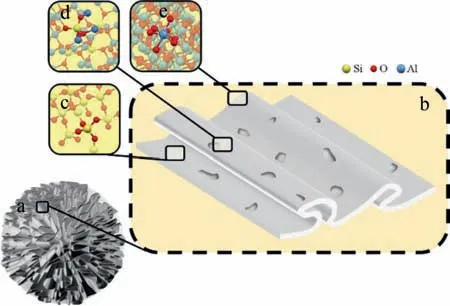
Fig.1.Overview of Al-DFNS on different scales.(a) A dandelion-like Al-DFNS nanosphere.(b) Closer inspection of the wall.(c) In Al-DFNS the framework of SiO2.(d) The 3D framework consisting of SiO4 and AlO4 tetrahedra.(e) The extra framework of Al2O3 [9].
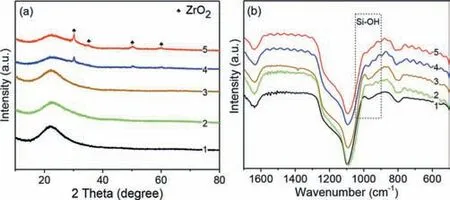
Fig.2.(a) XRD and corresponding (b) FT-IR spectra of the pure DFNS and varying modified DFNS:(1) pure DFNS;(2) Al-DFNS;(3) DeAl-DFNS;(4) Zr-DeAl-DFNS;(5)SZ-DeAl-DFNS.
The scanning electron microscopy (SEM) and transmission electron microscopy (TEM) images of varying dandelion-like DFNS particles with different components and channel densities are shown in Fig.3.All the samples present type IV isotherms with an H3 hysteresis loop shown in Fig.3c.The initial generation DFNS particles grow radially and uniformly with a mean diameter of~245 nm(Fig.3a1).The center-radial micro-mesopore channels (from 1.39 to 1.74 nm) can be clearly observed in the TEM image (Figs.3b1and d1),where the BET surface area is measured to be~991 m2/g and the pore volume measured to be~1.66 cm3/g.To achieve uniform distribution and remain dendritic fibrous features,different aluminum resources (NaAlO2and Al(C3H7O)3) were added in the first DFNS synthetic protocol,resulting in disorganized mesostructures (Fig.S1 in Supporting information) and hierarchically welldefined micro-mesostructures (Figs.3a2and b2),respectively.TEM image shows that the Al-DFNS have smaller size (~228 nm) and wider pore size contribution (1.10–1.87 nm) (Figs.3b2and d2).Compared with the first DFNS,the BET surface area and the total pore volume of the second Al-DFNS are found to be~1454 m2/g and 1.94 cm3/g respectively,which are apparently larger than those of the first generation.To understand the complex synthesis procedure and modifications,porosity properties of DFNSs are necessary.Three indicators to the structures of DFNS,Al-DFNS,DeAl-DFNS,Zr-DeAl-DFNS and SZ-DeAl-DFNS were detected and summarized in Table 1.The addition of Al(C3H7O)3to the DFNS synthetic mixture led to higher surface area,larger pore volume and total pore size(Table 1,entries 1 and 2).It is possible that the modifications cover the surface of DFNS,increasing the acid sites for further alkylation.

Table 1 Surface area and porosity properties of DFNS,Al-DFNS,DeAl-DFNS,Zr-DeAl-DFNS and SZ-DeAl-DFNS materials.

Fig.3.(a) SEM images,(b) TEM images,(c) N2 adsorption-desorption isotherms and (d) particle size distributions of (1) DFNS,(2) Al-DFNS and (3) SZ-DeAl-DFNS nanospheres.
We were excepting the introduction of zirconium into the DeAl-DFNS framework (Fig.4),leading to grafting of the zirconium atoms on the isolated silanol nets (Si-OH) groups [11].Fig.S2 (Supporting information) shows the27Al MAS NMR spectra of Al-DFNS which exhibits two peaks at around 53 and 0 ppm,attributed to the tetrahedral and octahedral aluminum [12].It seemed that the Al-O-Si framework formed in the Al-DFNS sample,supporting the proposed coordination environment of Fig.4.Both ZrOCl2and Zr(NO3)4in ethanol were treated at 110 °C and produced significantly different results,where ZrOCl2was favored of hydrolyzing on the located silanol nets.To reveal the status of zirconium and sulfur incorporated DeAl-DFNS,elemental mapping carried out by STEM/EDS of as-synthesized SZ-DeAl-DFNS is shown in Fig.5.All the oxides display homogenous distributions,which are attributed to tetrahedrally coordinated zirconium,with same imprints as for the following sulfur heteroatoms.The combined results indicate the possibility of zirconium species to incorporate into the internal surface of micro-mesopores.
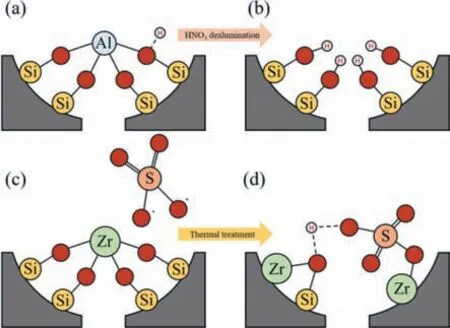
Fig.4.Hypotheses for modification of Al-DFNS by dealumination followed by incorporation of SO42-.
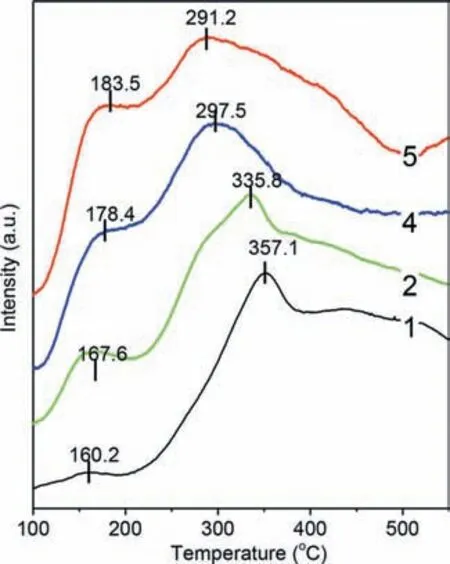
Fig.6.NH3-TPD curves of (1) DFNS,(2) Al-DFNS,(4) Zr-DeAl-DFNS and (5) SZ-DeAl-DFNS catalysts (DeAl-DFNS in Fig.S4 in Supporting information).
In the NH3-TPD of DFNSs,two major peaks at approximately 160–180 °C and 290–360 °C were observed,which are as-signed to week and strong acid sites (Fig.6).On the basis of the peak intensities and shifts,we supposed the reasonable catalytic behavior to the activated reactants,respectively of all the DFNSs.By modifications,the acid distribution became narrow while the amount of week acid sites gradually increased,demonstrating that the anthracene alkylation reaction is not only influenced by the acid strength,but relatively affected by acid distribution and the overall acid intensities.
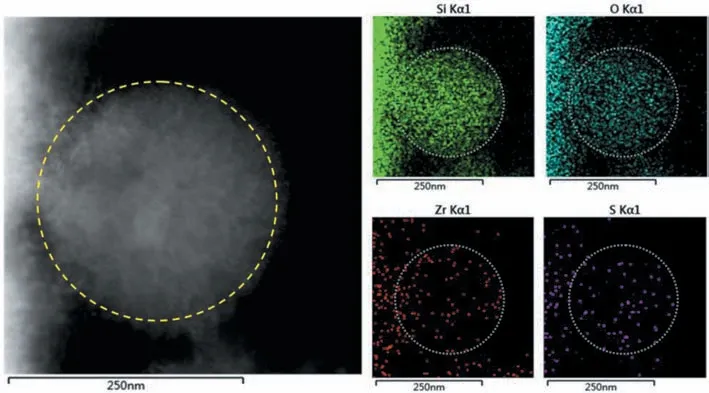
Fig.5.STEM images for SZ-DeAl-DFNS catalysts with EDS cartography of elements (Si) silicon,(O) oxygen,(Zr) zirconium and (S) sulfur (enlarged in Fig.S3 in Supporting information).
The alkylation reaction of anthracene was done with a series of DFNS catalysts summarized in Table 2 and displayed in Scheme 1.One commercial mesoporous acid catalyst,Al-MCM-41(Si/Al=25),was used as benchmarks (Table 2,entry 7).For none and pure DFNS,the direct rate of alkyl-anthracene production is constantly zero (entries 1 and 2),indicating that the process of anthracene alkylation totert–amylanthracene cannot be activated without Brönsted acid sites.After HNO3dealumination,no obvious acid sites were observed in NH3-TPD in Fig.S4 (Supporting information).Combined with the NH3-TPD,FT-IR and the results of experiment,a totally Al-removed DeAl-DFNS catalyst can be obtained without the collapse of mesoporous structure [12].Anthracene conversions are fairly similar for Al-DFNS and Zr-DeAl-DFNS catalysts,while SZ-DeAl-DFNS shows the highest catalytic activities of 60.8% (entries 3,5 and 6).Interestingly,we compared the properties of Al-DFNS and Al-MCM-41 with similar Si/Al ratio,the pore structure and aluminum distribution may be the reason for lower conversion of entry 7.For comparison,Lewis AlCl3and FeCl3were also listed in entries 8 and 9 with 100 wt% usage of unrecycled catalysts.Several side-products were detected in the anthracene alkylation reactions by GC/MS and1H NMR (Supporting information).In thetert–amylanthracene synthesis,a shapeselective catalyst and addition of anthracene appear to be productive.On the other hand,we can simply increase the ratio of anthracene/tert–amylacohol for besttert–amylanthracene selectivity (Fig.S5 in Supporting information).

Table 2 Conversion and selectivity in the alkylation of anthracene over various molecular sieves and Lewis catalysts.a
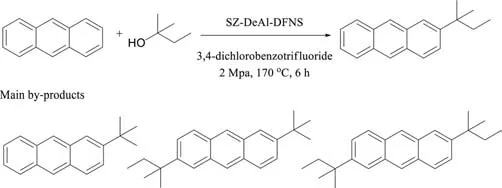
Scheme 1.SZ-DeAl-DFNS catalyzed alkylation of anthracene to tert–amylanthraccene and main by-products.
In conclusion,SZ-DeAl-DFNS solid acid is an efficient and shape-selective anthracene alkylation catalyst.Surface control in the fibrous DFNS can be achieved through dealumination and modifications of zirconium and sulfate.Adjusting the morphology of silica support while changing the acid distribution is critical in the catalytic anthracene alkylation.Further,it will be significant to apply solid acid in place of AlCl3Lewis acid for industrial production.
Declaration of competing interest
The authors declare that they have no known competing financial interests or personal relationships that could have appeared to influence the work reported in this paper.
Acknowledgment
This work is supported by the Zhejiang Provincial Key Laboratory of Advanced Chemical Engineering Manufacture Technology(No.2017E10001),Zhejiang Province,China.
Supplementary materials
Supplementary material associated with this article can be found,in the online version,at doi:10.1016/j.cclet.2021.04.024.
杂志排行
Chinese Chemical Letters的其它文章
- Progress in mechanochromic luminescence of gold(I) complexes
- Spinel-type bimetal sulfides derived from Prussian blue analogues as efficient polysulfides mediators for lithium-sulfur batteries
- Alopecuroidines A-C,three matrine-derived alkaloids from the seeds of Sophora alopecuroides
- Boronic acid-containing diarylpyrimidine derivatives as novel HIV-1 NNRTIs:Design,synthesis and biological evaluation
- Diaminodiacid bridge improves enzymatic and in vivo inhibitory activity of peptide CPI-1 against botulinum toxin serotype A
- Peptide stapling with the retention of double native side-chains
